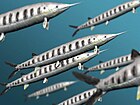Бананогмий
| Бананогмий Временный диапазон: Возможная альбианская запись
| |
|---|---|

| |
| Впечатление художника Б. Аратуса | |
| Научная классификация | |
| Домен: | Эукариота |
| Королевство: | Животное |
| Филум: | Chordata |
| Сорт: | Actinopterygii |
| Order: | †Tselfatiiformes |
| Family: | †Plethodidae |
| Genus: | †Bananogmius Whitley, 1940 |
| Type species | |
| †Anogmius aratus Cope, 1877
| |
| Species | |
| |
| Synonyms | |
| |
Bananogmius - вымерший род морской рыбы , которая была обнаружена в том, что сейчас является Северной Америкой и Европой во время позднего мела , от сеномана до сантониана . [ 1 ] Он жил в западном внутреннем морском пути , который разделил Северную Америку в двух во время позднего мелового , а также в прото- Северном море Европы. [ 2 ] [ 3 ] [ 4 ]
Таксономия
[ редактировать ]The original name for this genus was Anogmius Cope, 1871, which was described with the type species A. contractus. Shortly afterwards, Cope synonymized the genus with Pachyrhizodus, only to revive it in 1877 for species such as A. aratus, A. favirostris, and A. evolutus. Cope's synonymy of this genus with Pachyrhizodus was variously accepted or rejected for several decades, until 1940 when the new genus Bananogmius was proposed to contain all members of Anogmius aside from the type species, which was assumed to be a synonym of Pachyrhizodus. Further analysis of Cope's description of the original Anogmius contractus confirms that it was a plethodid and not a pachyrhizodontid, but this specimen was too fragmentary for a proper diagnosis and is now lost, leaving Bananogmius as the valid name.[1]
The following species are known:[1]
- †B. aratus (Cope, 1877) - Turonian to Santonian of the Niobrara Chalk in Kansas, USA (type species) (=Anogmius aratus Cope, 1877)
- †B. favirostris (Cope, 1877) - Turonian to Santonian of the Niobrara Chalk in Kansas, USA (=Anogmius favirostris Cope, 1877)
- †B. ellisensis Fielitz & Shimada, 1999 - Turonian of the Carlile Shale in Kansas, USA[5]
- †B. ornatus (Woodward, 1923) - Cenomanian of England (Chalk Group), Cenomanian/Turonian of Germany (Hesseltal Formation) (=Anogmius ornatus Woodward, 1923)[4][6][7]
Specimens are known from the Turonian and possibly the Albian (Tlayúa Formation) of Mexico, although these have not yet been described.[8] Some species formerly placed in this genus, such as B. evolutus Cope, 1877 and B. crieleyi Applegate, 1970 were later reclassified as Pentanogmius.[9]
Description
[edit]As with many plethodids, Bananogmius had a thin body reminiscent of the modern angelfish, dozens of small teeth, and a high dorsal fin.[10]
Ecology
[edit]Bananogmius appears to have been a medium-sized predator that swallowed its prey headfirst. A fossil of B. ornatus from Germany from around the Cenomanian-Turonian boundary is preserved with the skeletons of the small schooling fish Clupavus in its stomach.[4] This fish also has crushing teeth, indicating that it may have preyed upon marine mollusks.[5]
References
[edit]- ^ Jump up to: a b c Taverne, Louis (2001). "Révision du genre Bananogmius (Teleostei, Tselfatiiformes), poisson marin du Crétacé supérieur d'Amérique du Nord et d'Europe". Geodiversitas. 23 (1): 17–40.
- ^ Fielitz C, Shimada K. 1999. A new species of Bananogmius (Teleostei; Tselfatiformes) from the Upper Cretaceous Carlile Shale of western Kansas. Journal of Paleontology 73(3): 504-511.
- ^ Taverne L. 2001. Révision du genre Bananogmius (Teleostei, Tselfatiiformes), poisson marin du Crétecé supérior d'Amérique du Nord et d'Europe. Geodiversitas 23(1):17-40.
- ^ Jump up to: a b c Hunt, Adrian P.; Milàn, Jesper; Lucas, Spencer G.; Spielmann, Justin A. (2012). Vertebrate Coprolites: Bulletin 57. New Mexico Museum of Natural History and Science.
- ^ Jump up to: a b Fielitz, Christopher; Shimada, Kenshu (1999). "A new species of Bananogmius (Teleostei: Tselfatiformes) from the Upper Cretaceous Carlile Shale of western Kansas". Journal of Paleontology. 73 (3): 504–511. Bibcode:1999JPal...73..504F. doi:10.1017/S0022336000028018. ISSN 0022-3360.
- ^ Friedman, Matt; Beckett, Hermione T.; Close, Roger A.; Johanson, Zerina (2016). "The English Chalk and London Clay: two remarkable British bony fish Lagerstätten". Geological Society, London, Special Publications. 430 (1): 165–200. Bibcode:2016GSLSP.430..165F. doi:10.1144/SP430.18. ISSN 0305-8719.
- ^ Amalfitano, Jacopo; Giusberti, Luca; Fornaciari, Eliana; Carnevale, Giorgio (2020-04-03). "Upper Cenomanian Fishes From the Bonarelli Level (OAE2) of Northeastern Italy". Rivista Italiana di Paleontologia e Stratigrafia. 126 (2). doi:10.13130/2039-4942/13224. ISSN 2039-4942.
- ^ Стиннесбек, Ева Сюзанна; Гердер, Фабиан; Ржавчина, Джес; Stinnesbeck, Wolfgang (2023-02-01). «Спикер телекоммуникационной системы Formosa Arambourg, 1943 из Vallecillo, NE Мексика » Plos один 18 (2): E0280797. Bibcode : 2023ploso..1880797S Doi : 10.1371/ journal.pone.0280797 ISSN 1932-6 9891505PMC 36724176PMID
- ^ Таверна Л. (2000). «Остеология и систематическое положение жанра Plethodus и новых жанров Dixonanogmius и Pentanogmius , морские рыбы из меловых (Teleostei, tselfatiiformes)». Biologisch Jaarboek Dodonaea . 67 (1): 94–123.
- ^ Эверхарт, Майк (23 августа 2011 г.). «Плетодиды». Океаны Канзаса. Получено 28 апреля 2014 года.
- Tsyatiformes
- Доисторические роды рыбы с лучами
- Поздняя меловая костная рыба
- Поздняя меловая рыба Северной Америки
- Меловая рыба Европы
- Род сеномана в первую очередь
- Туронийские роды
- Ген коньяка генерирует
- Сантонианский род вымирание
- Окаменелости Соединенных Штатов
- Окаменелости Мексики
- Окаменелости Англии
- Окаменелости Германии
- Естественная история Канзаса
- Ископаемые таксоны описаны в 1940 году
- Доисторические рыбные заглушки с лучами






